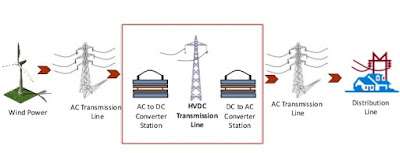A scheme diagram of HVDC Transmission is shown below for ease in understanding the advantages and disadvantages.
Advantages of HVDC:
There is a list of advantages of High Voltage DC Power Transmission, HVDC when compared with High Voltage AC Power Transmission, HVAC. They are listed below with detail while comparing with HVAC.
Line Circuit:
The line construction for HVDC is simpler as compared to HVAC. A single conductor line with ground as return in HVDC can be compared with the 3-phase single circuit HVAC line (Why? Can’t we supply power with two phases in HVAC?). As because when Line to Earth Fault or Line-Line Fault 3-phase system cannot operate. This is why we compared the a single conductor line with ground as return can be compared with the 3-phase single circuit HVAC line.
Thus HVDC line conductor is comparatively cheaper while having the same reliability as 3-phase HVAC system.
Power Per Conductor:
Power Per conductor in HVDC Pd = VdId
Power Per Conductor in HVAC Pa = VaIaCosØ
Where Id and Iaare the line current in HVAC and HVDC circuit respectively & Vdand Va are the voltage of line w.r.t ground in HVDC and HVAC respectively.
As crest voltage is same for Insulators of Line, therefore line to ground voltage in HVDC will be root two (1.414) times that of rms value of line to ground voltage in HVAC.
Vd = 1.414Vaand Id = Ia (assumed for comparison purpose)
Therefore,
Pd / Pa = VdId / VaIaCosØ
= VdId / (Vd/1.414)IdCosØ
= 1.414/CosØ
As CosØ <= 1,
Pd /Pa>1
Pd >Pa
Therefore, we see that power per conductor in HVDC is more as compared to HVAC.
Power Per Circuit:
Now, we will compare the power transmission capabilities of 3-phase single circuit line with Bipolar HVDC Line. (Bipolar HVDC Line have two conductors one with +ive polarity and another with –ive polarity.)
Therefore, for Bipolar HVDC Line,
Pd = 2×VdId
While for HVAC Line,
Pac = 3×VaIaCosØ
Hence,
Pd / Pac= 2VdId / 3VaIaCosØ
But Vd = 1.414Vaand Id = Ia
Pd/Pac= (2×1.414) / 3CosØ
= 2.828/ 3CosØ ≈ 0.9 (as CosØ <1)
Thus we see that power Transmission Capability of Bipolar HVDC Line is same as 3-phase single circuit HVAC Line. But in case of HVDC, we only need two conductors while in 3-phase HVAC we need three conductors, therefore number of Insulators for supporting conductors on tower will also reduce by 1/3. Hence, HVDC tower is cheaper as compared to HVAC.
Observe the figure below carefully, you will get to know three important points about HVDC
No Charging Current:
Unlike HVAC, there is no charging current involved in HVDC which in turn reduces many accessories.
No Skin Effect:
In HVDC Line, the phenomenon of Skin Effect is absent. Therefore current flows through the whole cross section of the conductor in HVDC while in HVAC current only flows on the surface of conductor due to Skin Effect.
No Compensation Required:
Long distance AC power transmission is only feasible with the use of Series and Shunt Compensation applied at intervals along the Transmission Line. For such HVAC line, Shunt Compensation i.e. Shunt Reactor is required to absorb KVARs produced due to the line charging current (because the capacitance of line will dominate during low load / light load condition which is famously known as Farranty Effect.) during light load condition and series compensation for stability purpose.
As HVDC operates at unity power factor and there is no charging current, therefore no compensation is required.
Less Corona Loss and Radio Interference:
As we know that, Corona Loss is directly proportional to (f+25) where f is frequency of supply. Therefore for HVDC Corona Loss will be less as f=0. As Corona Loss is less in HVDC therefore Radio Interference will also be less compared to HVAC.
The interesting thing in HVDC is that, Corona and Radio Interference decreases slightly by foul whether condition like snow, rain or fog whereas they increases Corona and hence Radio Interference in HVAC.
Higher Operating Voltage:
High Voltage Transmission Lines are designed on the basis of Switching Surges rather than Lightening Surges as Switching Surges is more dangerous compared to Lightening Surges.
As the level of Switching Surges for HVDC is lower as compared with HVAC, therefore the same size of conductors and Insulators can be used for higher voltage for HVDC when compared with HVAC.
No Stability Problem:
As we know that for two Machine system, power transmitted,
P = (E1E1Sinδ)/X
Where X is inductive reactance of the line, E1 & E2 are the sending and receiving end voltage respectively.
As the length of line increases the value of X increases and hence lower will be the capability of Machine to transmit power from one end to another. Thus, reducing the Steady State Stability Limit. As the Transient Stability Limit is lower than Steady State Stability Limit, thus for longer line Transient Stability Limit becomes very poor.
HVDC do not have any Stability problem in itself as the DC operation is asynchronous operation of Machine.
Now, we will come to disadvantage of HVDC.
Disadvantage of HVDC:
Expensive Converters:
The converters used at both end of line in HVDC are very costly as compared to the equipment used in AC. The converters have very little overload capacity and need reactive power which in turn needs to be supplied locally.
Also Filters are required at the AC side of each converter which also increases the cost.
Voltage Transformation:
Electric Power is used generally at low voltage only. Voltage Transformation is not easier in case of DC.
So, why don’t we use HVDC as it has many advantages over HVAC? To know, please read “Deciding Factor for Selection of HVDC over HVAC Transmission“. Thank you friends!


In HVDC transmission cost of construction as 1/3 of HVAC, Stability maintained compared to Ac , In
HVDC line loss is nominal, only major disadvantage HVDC no have transformer action.